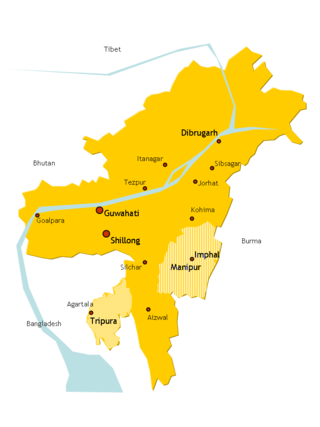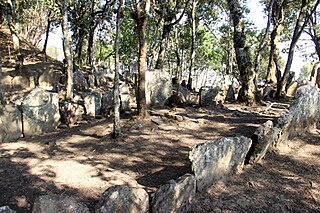Lalthangfala Sailo | |
|---|---|
| Born | 1933 |
| Occupation(s) | Writer Educationist |
| Known for | Writings, Social work, Education |
| Spouse | Lalhrimi Sailo |
| Children | Ngurzidinga Sailo, Ngursangliana Sailo, Ngurhlunchhunga Sailo, Ngurzikpuii Sailo |
| Parent | Dohleia Sailo (L), |
| Awards | Padma Shri, Sangeet Natak Akademi Award on playwright, Bharat Adivasi Award, Pu Buanga Award |
Lalthangfala Sailo is an Indian educationist, short story writer, playwright and a former president of the Mizo Academy of Letters. [1] [2] He is a former deputy registrar at the Mizoram campus of the North Eastern Hill University. [3] [4]
He has written several articles in Mizo language [5] and has published several books including:
The Government of India awarded him the fourth highest civilian honour of the Padma Shri, in 2009, for his contributions to Education. [10]

The Mizo people, historically recorded as the Lushais, are an ethnic group native to the state of Mizoram in India and neighbouring states of Northeast India. They speak the Tibeto-Burman language of Mizo, the official language and lingua franca of Mizoram. The state is the second most literate state in India, at more than a rate of 90%.

The history of Mizoram encompasses the history of Mizoram which lies in the southernmost part of northeast India. It is a conglomerate history of several ethnic groups of Chin people who migrated from Chin State of Burma. But information of their patterns of westward migration are based on oral history and archaeological inferences, hence nothing definite can be said. The recorded history started relatively recently around the mid-19th century when the adjoining regions were occupied by the British monarchy. Following religious, political and cultural revolutions in the mid-20th century majority of the people agglomerated into a super tribe, Mizo. Hence the officially recognised settlement of the Mizos became Mizoram.
Pachhunga University College (PUC) is a public institute in Aizawl, Mizoram, and the only constituent college of Mizoram University, a central university established by an Act of Parliament of India. Founded in 1958 as Aijal College, it is the oldest and largest college in Mizoram, by enrolment and campus size. It started with intermediate of arts courses, and later expanded to bachelor's degrees in arts, commerce and science. With the opening of master's degree courses in Mizo, philosophy and life sciences, it became the first postgraduate college in Mizoram.
Brigadier Ṭhenphunga Sailo, AVSM (1922–2015) was an Indian military officer and politician who served as the 2nd Chief Minister of Mizoram. He founded the Mizoram People's Conference, one of the major political parties in Mizoram. He was a recipient of Ati Vishisht Seva Medal and Padma Shri for his military service and humanitarian works, and the Mizo Award for his lifetime achievements.
Mizo literature is the literature written in Mizo ṭawng, the principal language of the Mizo peoples, which has both written and oral traditions. It has undergone a considerable change in the 20th century. The language developed mainly from the Lushai language, with significant influence from Pawi language, Paite language and Hmar language, especially at the literary level.

Padma Sachdev was an Indian poet and novelist. She was the first modern woman poet of the Dogri language. She also wrote in Hindi. She published several poetry collections, including Meri Kavita Mere Geet, which won the Sahitya Akademi Award in 1971. She also received the Padma Shri, India's fourth highest civilian award in 2001, and the Kabir Samman for poetry for the year 2007-08 given by Government of Madhya Pradesh, Saraswati Samman for the year 2015, Sahitya Akademi Fellowship in 2019.
Zairema was a Presbyterian minister, and a pioneer in theology and literature among the Mizo people of northeast India. He was the first Mizo to obtain the degrees of BSc and BD. He died of cardiac problem on the morning of 17 December 2008 at his residence in Aizawl at the age of 91. He is best remembered as the "father of Mizoram Synod".
Edwin Rowlands was a Welsh Christian missionary in northeast India and Burma. He was a professional teacher, singer, composer, poet, translator and literary figure among the Mizo people. He was regarded as the most beloved of all British missionaries in Mizoram. He was more popularly known as Zosapthara. He made the major hymns in Mizo and Khumi which are still in use. He modified the original Mizo alphabet and his system became the standard in Mizo language. He created written language for Khumi people in Burma, and for Bhil people in Maharashtra. His literary works are the foundation of Mizo literature. He was the first administrator of education in Mizoram as Honorary Inspector of Schools. Despite objection from various corners he married Thangkungi, a Mizo girl.

The history of Christianity in Mizoram covers the origin and development of all forms of Christianity in Mizoram since the British occupation at the end of the 19th century. Christianity arrived as a consequence of tribal warfare, raids of British plantations, and the ensuing punitive British military expedition called the Lushai Expedition of 1871. The subsequent annexation of the erstwhile Lushai Hills to the British Empire opened the gateway for British Christian missions to evangelise the Mizo people.
Sângthankima is a humanitarian and social worker in Mizoram, India. He is the founder of Thutak Nunpuitu Team (TNT), a voluntary organisation, which runs the largest charitable institution in Mizoram. His institution, a registered society since 1991 under the Firms and Societies in India, started as a rehabilitation society for alcoholics in Champhai town. With donation of a plot of land in Aizawl city, it expanded into an orphanage with formal school, health centre, and sanatorium. He received the Padma Shri Award in 2024.
Ralte L. Thanmawia is an Indian educationist and writer from Mizoram.
Elangbam Nilakanta Singh (1927-2000) was an Indian poet and critic, considered by many as one of the pioneers of modern Meitei literature. A recipient of the Sahitya Akademi Award in 1987, Nilakanta Singh was honored by the Government of India, in 2000, with the fourth highest Indian civilian award of Padma Shri.
Nuchhungi Renthlei was an Indian poet, singer and school teacher, known for her poems written in Mizo language. She was the founder of Girls' Auxiliary, an organization for women's rights, which she founded in 1939. The Government of India awarded her the fourth highest civilian honour of Padma Shri in 1986.

Mizoram is a state in the northeast of India. Mizoram is considered by many as a beautiful place due to its landscape and pleasant climate. There have been many attempts to increase revenue through tourism but many potential tourists find the lack of amenities to be a hurdle. However, the State continues to promote itself and many projects have been initiated. The tourism ministry continues to maintain or upgrade its tourist lodges throughout the state. Foreign tourists are required to obtain an 'inner line permit' under the special permit before visiting. The permit can be obtained from Indian missions abroad for a limited number of days or direct from Mizoram Government authorities within India. The state is rich in bird diversity, which has the potentiality to make it a major birding destination. Mizoram is a stronghold for Mrs. Hume's pheasant. There is also a rare record of the wild water buffalo from the state. There are several past records of the Sumatran rhinoceros from Mizoram, then Lushai Hills. The small population of wild elephants can be seen in Ngengpui and Dampa Sanctuaries.
Lalsangzuali Sailo was a writer, gospel singer and music composer from Mizoram. She has written over 300 songs, in Mizo, Kokborok and English.
Pahlira Sena Chawngthu (1922–2005) was a Mizo poet, singer, and radio broadcaster from the Indian state of Mizoram.

Laltluangliana Khiangte is a Mizo academic, playwright and poet of Mizo literature. He was the principal of the Serampore College and a former professor at Pachhunga University College and the North Eastern Hill University. He is presently serving as the senior most professor at the Department of Mizo at Mizoram University. He is a recipient of the Pu Buanga Award, the highest literary award of the Mizo Academy of Letters. The Government of India awarded him the fourth highest civilian honour of the Padma Shri, in 2006, for his contributions to Indian literature.
Lalzuia Colney is an Indian academic and writer of Mizo literature.
L. Z. Sailo is an Indian writer and a former captain of the Indian Army. He has also served in the UN Peace Keeping Force at Congo and one of his books, Runlum Nuthai, was selected as the Mizo Academy of Letters Book of the Year in 2002. The Government of India awarded him the Padma Bhushan, the third highest civilian award, in 2007.
Lalthlamuong Keivom was an Indian diplomat, writer and composer of Mizo literature and Hmar literature. Keivom was nicknamed Zoram Khawvel Pa after his treatise Zoram Khawvel and for his contribution towards the integration of Zo people.